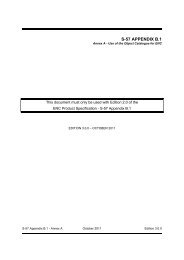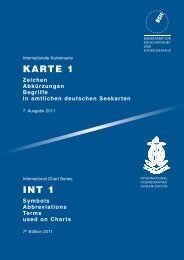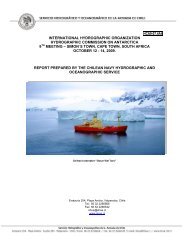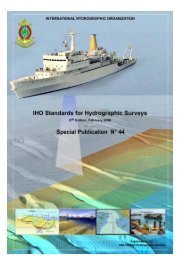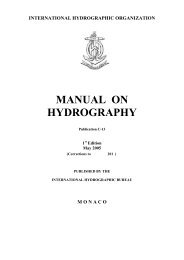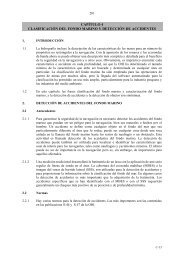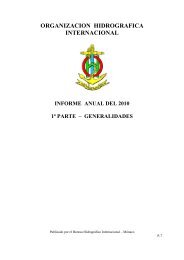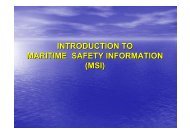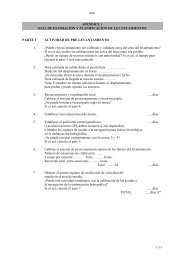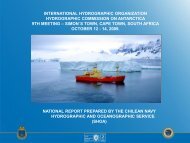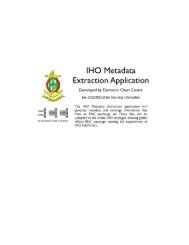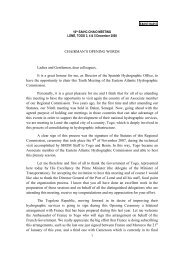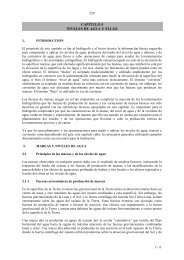- Page 1 and 2: Servicio de Hidrografía Naval NAVE
- Page 3 and 4: Capítulo 9 IDENTIFICACION, NOCIONE
- Page 5 and 6: PROTOCOLO AL TRATADO ANTARTICO SOBR
- Page 7 and 8: mayor conocimiento sobre el medio a
- Page 9 and 10: 2. Otros Anexos, adicionales a los
- Page 11 and 12: miento de este protocolo, las Parte
- Page 13 and 14: han acordado el medio para resolver
- Page 15 and 16: Artículo 2 1. Cada Parte tendrá e
- Page 17 and 18: disposición, la proporcionarán to
- Page 19 and 20: (d) una estimación de la naturalez
- Page 21 and 22: ANEXO II AL PROTOCOLO AL TRATADO AN
- Page 23 and 24: plataformas de hielo, y los perros
- Page 25 and 26: ANEXO III AL PROTOCOLO AL TRATADO A
- Page 27 and 28: ARTICULO 5 ELIMINACION DE RESIDUOS
- Page 29 and 30: ción del medio ambiente. 2. La not
- Page 31 and 32: sufridas por un buque o por sus equ
- Page 33 and 34: ARTICULO 14 RELACION CON MARPOL 73/
- Page 35 and 36: La zona cuya designación se propon
- Page 37 and 38: Antárticas Especialmente Protegida
- Page 39 and 40: Capítulo 1 ASPECTOS NORMATIVOS DE
- Page 41 and 42: Hidrográfica Internacional (OHI).
- Page 43 and 44: Anexo 1 Las Partes Consultivas del
- Page 45: 9. VESSEL FACILITIES-GENERAL CARGO
- Page 49 and 50: Anexo 2 CONTENIDO DEL PROYECTO DE C
- Page 51 and 52: mundial está dado por este hecho v
- Page 53 and 54: Debe tenerse presente que el MARPOL
- Page 55 and 56: acorde con el tipo de hidrocarburo
- Page 57 and 58: Anexo A Plan Nacional de Contingenc
- Page 59 and 60: • Productos avícolas introducido
- Page 61 and 62: • Categoría C: ligeramente tóxi
- Page 63 and 64: Los afloramientos rocosos ocupan s
- Page 65 and 66: nínsula Antártica y Sudamérica c
- Page 67 and 68: tiempo. 3.9 Datos sísmicos Los mé
- Page 69 and 70: cabellado". Es poco probable que, e
- Page 71 and 72: 3-10
- Page 73 and 74: 3-12
- Page 75 and 76: 3-14
- Page 77 and 78: 3-16
- Page 79 and 80: 3-18
- Page 81 and 82: distribución de los campos de temp
- Page 83 and 84: Las masas de aguas cercanas al cont
- Page 85 and 86: En la figura siguiente se muestra c
- Page 87 and 88: En sus frentes, las barreras presen
- Page 89 and 90: En 1983 el Grupo de Trabajo de Glac
- Page 91 and 92: la costa occidental de la penínsul
- Page 93 and 94: Descripción de figuras Figura 1: M
- Page 95 and 96: Capítulo 6 FAUNA ANTARTICA Y CONSE
- Page 97 and 98:
circulaciones ciclónicas vinculada
- Page 99 and 100:
1) Zona del Frente Polar (ZFP) 2) C
- Page 101 and 102:
iv)La reproducción no es exitosa e
- Page 103 and 104:
dieta de casi todas las aves. Los p
- Page 105 and 106:
del ecosistema en forma total y no
- Page 107 and 108:
6-13
- Page 109 and 110:
6-15
- Page 111 and 112:
7.5.2.2 Ondas orográficas 7.5.2.3
- Page 113 and 114:
Estas variaciones también se puede
- Page 115 and 116:
hidrometeoros y la variación espac
- Page 117 and 118:
este proceso se desarrolla en una c
- Page 119 and 120:
cie. Teóricamente se ha estudiado
- Page 121 and 122:
7-12
- Page 123 and 124:
7-14
- Page 125 and 126:
7.3 Comentarios con respecto a los
- Page 127 and 128:
No hay observaciones meteorológica
- Page 129 and 130:
Veremos con un poco más de detalle
- Page 131 and 132:
7.5.3.2 Vientos catabáticos El vie
- Page 133 and 134:
7.6.1.2 Variación de la dirección
- Page 135 and 136:
7.7.1.3 Características de las nub
- Page 137 and 138:
Capítulo 8 HIELO MARINO Ernesto Em
- Page 139 and 140:
8.1.2 Núcleos de cristalización H
- Page 141 and 142:
y densidad las responsables de que
- Page 143 and 144:
De la mayoría de estas variables e
- Page 145 and 146:
ESPESOR DE HIELO DE MAR CALCULADO S
- Page 147 and 148:
ESPESOR DE HIELO DE MAR CALCULADO S
- Page 149 and 150:
que emerge y mayor va a ser la velo
- Page 151 and 152:
Por otra parte también demuestra q
- Page 153 and 154:
Capítulo 9 IDENTIFICACIÓN, NOCION
- Page 155 and 156:
9.2.2 Formas de hielo marino La for
- Page 157 and 158:
En efecto, el primer caso (a) corre
- Page 159 and 160:
dimentos de arena y desperdicios. S
- Page 161 and 162:
Anexo 1 Terminología del hielo seg
- Page 163 and 164:
ido al derretimiento de la nieve, p
- Page 165 and 166:
la deriva con concentraciones clara
- Page 167 and 168:
del agua en la superficie; y hielo
- Page 169 and 170:
amonticulado. Hay montículos varad
- Page 171 and 172:
Capítulo 10 SUPERVIVENCIA EN LA AN
- Page 173 and 174:
El antídoto psicológico contra am
- Page 175 and 176:
pervivencia. El personal deberá pr
- Page 177 and 178:
10.3.3 Alojamiento sobre hielo mari
- Page 179 and 180:
c) Foca de Ross Considerada circump
- Page 181 and 182:
se denomina “ciempiés” y se co
- Page 183 and 184:
S obrevivir es su única misión. O
- Page 185 and 186:
11.1 Introducción Muchos libros y
- Page 187 and 188:
do puede ser: cordones de hielo, zo
- Page 189 and 190:
LLEVE TODO LO QUE PUEDA AUMENTAR SU
- Page 191 and 192:
do, hielo fragmentado o charcos sob
- Page 193 and 194:
del buque y otros buques en la zona
- Page 195 and 196:
Capítulo 12 PRIMEROS AUXILIOS EN L
- Page 197 and 198:
nestar personal y el mantenimiento
- Page 199 and 200:
estrechas para los ojos. El efecto
- Page 201 and 202:
El tratamiento es la respiración a
- Page 203 and 204:
Método de Eve Schaver Método de S
- Page 205 and 206:
Capítulo 13 PROTECCION Y CONSERVAC
- Page 207 and 208:
Anexo Actividad Evaluación de Impa
- Page 209 and 210:
PRECAUCIONES PARA PREVENIR LA INTRO
- Page 211 and 212:
tipo de disturbio que pueda modific
- Page 213 and 214:
Fecha Buque Arribo Partida Perm. (m
- Page 215 and 216:
Todas las estadísticas realizadas
- Page 217 and 218:
LA CLASIFICACION “APTOS PARA LA N
- Page 219 and 220:
Filmina 3 Filmina 4 14 - 4
- Page 221 and 222:
determinadas regulaciones para el r
- Page 223 and 224:
estructuras internas, que se satisf
- Page 225 and 226:
CLASE/COTA QUE SE OTORGA Veamos el
- Page 227 and 228:
lado el Calado máximo tomado en el
- Page 229 and 230:
Región de popa (A): ésta. compren
- Page 231 and 232:
Filmina 12 Filmina 13 14 - 16
- Page 233 and 234:
POTENCIA DE LA MAQUINARIA PROPULSOR
- Page 235 and 236:
CRITERIOS PARA EL DIMENSIONAMIENTO
- Page 237 and 238:
que h 0 y se la toma como valor de
- Page 239 and 240:
atraviesa, por medio de contretes.
- Page 241 and 242:
Filmina 19 14 - 26
- Page 243 and 244:
τ el espaciado entre bulárcamas.
- Page 245 and 246:
varengas o consolas espaciadas no m
- Page 247 and 248:
Se recomienda dividir las mismas en
- Page 249 and 250:
Filmina 24 14 - 34
- Page 251 and 252:
CLASE/COTA QUE OTORGA (Filmina N°
- Page 253 and 254:
F: distancia horizontal entre la pe
- Page 255 and 256:
caso afectada por un coeficiente se
- Page 257 and 258:
ENCHAPADO DE CASCO (Filmina N° 30)
- Page 259 and 260:
CUADERNAS TRANSVERSALES Y LONGITUDI
- Page 261 and 262:
DIMENSIONAMIENTO DE OTROS ELEMENTOS
- Page 263 and 264:
Filmina 33 Almas y alas deben verif
- Page 265 and 266:
De ser necesario mantener la dimens
- Page 267 and 268:
TEMPERATURA DE DISEÑO Filmina 36 P
- Page 269 and 270:
FINNISH - SWEDISH ICE CLASS RULES C
- Page 271 and 272:
DETERMINACION DE LA CLASE DE HIELO
- Page 273 and 274:
BUQUES DAÑADOS Filmina 39 Para el
- Page 275 and 276:
σ σ σ σ Quillas de rolido. Hél
- Page 277 and 278:
Capítulo 15 NAVEGACIÓN Y SEGURIDA
- Page 279 and 280:
de no adoptar precauciones ante la
- Page 281 and 282:
aceptable. De más está decir que
- Page 283 and 284:
• El pack condiciona la derrota
- Page 285 and 286:
gún las características de diseñ
- Page 287 and 288:
Capítulo 16 OPERACION DE HELICOPTE
- Page 289 and 290:
como sorpresivos, especialmente la
- Page 291 and 292:
Debe tenerse en cuenta que el helic
- Page 293 and 294:
en los planes en vigor, a los reque
- Page 295 and 296:
estar adiestrado para tomar inmedia
- Page 297 and 298:
Apéndice 1 PREPARACION, PLANIFICAC
- Page 299 and 300:
- Nº Viajes/día (lancha - hielo).
- Page 301 and 302:
A1-5
- Page 303 and 304:
A1.6 Comentarios finales • Es fun
- Page 305 and 306:
A2.2 Pautas a cumplir por los capit
- Page 307 and 308:
Apéndice 3 EXTRACCION DE HIDROCARB
- Page 309 and 310:
traslado, tendido y remolque de la
- Page 311 and 312:
Apéndice 4 INMERSION EN AGUAS FRIA
- Page 313 and 314:
A4.4 Producción y regulación del
- Page 315 and 316:
tiempo diario de 16 minutos de inme
- Page 317 and 318:
Son de suma utilidad para buceos de
- Page 319 and 320:
Los guantes y mitones de neopreno d
- Page 321 and 322:
Aun así, superando todos estos obs
- Page 323 and 324:
A5.6 Conclusiones No es necesaria u
- Page 325 and 326:
A5-6
- Page 327 and 328:
A6.1 Introducción El presente estu
- Page 329 and 330:
La orografía y orientación de las
- Page 331 and 332:
pasajes la más aconsejable para in
- Page 333 and 334:
A6-8 mes (13 días). Ver figura n°
- Page 335 and 336:
El planificador debe saber que esto
- Page 337 and 338:
en temporales, el mar arbola mucho,
- Page 339 and 340:
A6.10 Bibliografía Derrotero argen
- Page 341 and 342:
Figura 3 A6-16
- Page 343 and 344:
A6-18
- Page 345 and 346:
A6-20
- Page 347 and 348:
Figura 11a Figura 11b A6-22
- Page 349 and 350:
Figura 13 A6-24
- Page 351 and 352:
Figura 15 A6-26
- Page 353 and 354:
Figura 17 Figura 18 A6-28
- Page 355 and 356:
A6-30
- Page 357 and 358:
A7.2 El hielo como recurso natural
- Page 359 and 360:
gla MARPOL 73/78, incluye a la Ant
- Page 361 and 362:
Otra característica de estos peque
- Page 363 and 364:
Apéndice 8 NAVEGACIÓN SATELITAL C
- Page 365 and 366:
planos orbitales de aproximadamente
- Page 367 and 368:
A8.4 Estructura de la señal. Los r
- Page 369 and 370:
Sin embargo, debemos considerar que
- Page 371 and 372:
Nos referiremos sólo a aquellos er
- Page 373 and 374:
proximidad de estructuras reflectan
- Page 375 and 376:
Una buena distribución es aquella
- Page 377 and 378:
Por su parte, los productos de post
- Page 379 and 380:
configuración satelital. Es decir,
- Page 381 and 382:
Las falencias de la geometría de l
- Page 383 and 384:
• http://giant.gd-ais.com/ • ht
- Page 385 and 386:
A9.1 La forma de la tierra. Como re
- Page 387 and 388:
A medida que se obtenía una mejor
- Page 389 and 390:
Al respecto y por último, debemos
- Page 391 and 392:
las RNC deban ser utilizadas en par
- Page 393 and 394:
• Cartografía Electrónica- Gene
- Page 395 and 396:
A10.2 Ventajas y desventajas compar
- Page 397 and 398:
Apéndice 11 DISIMILITUDES ANTARTID
- Page 399 and 400:
Apéndice 11 ANTARCTICA - ARTIC DIS
- Page 401:
BIBLIOGRAFIA NAUTICA RECOMENDADA



